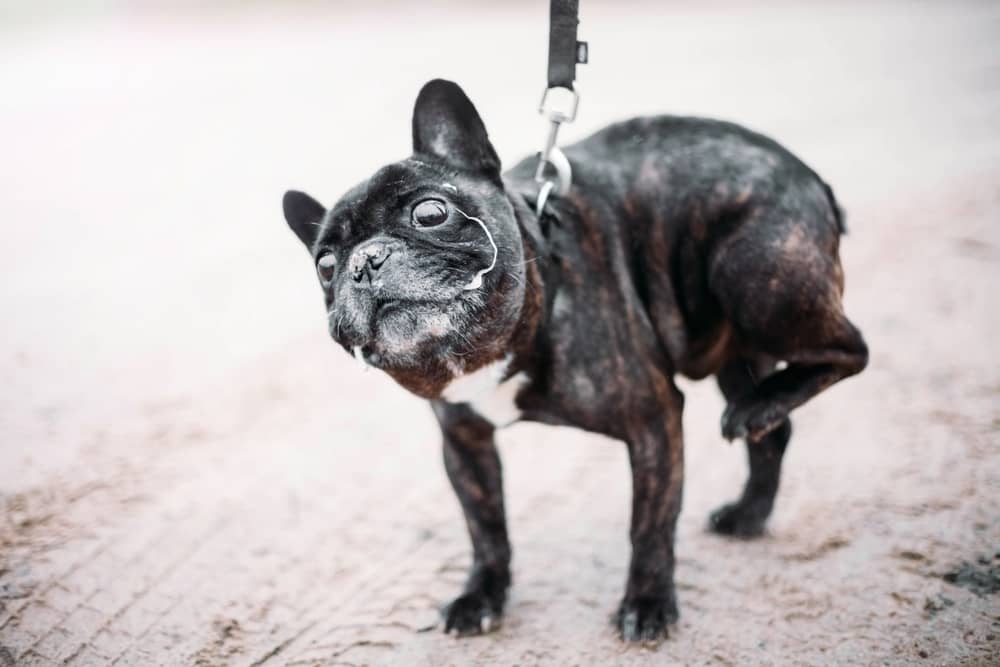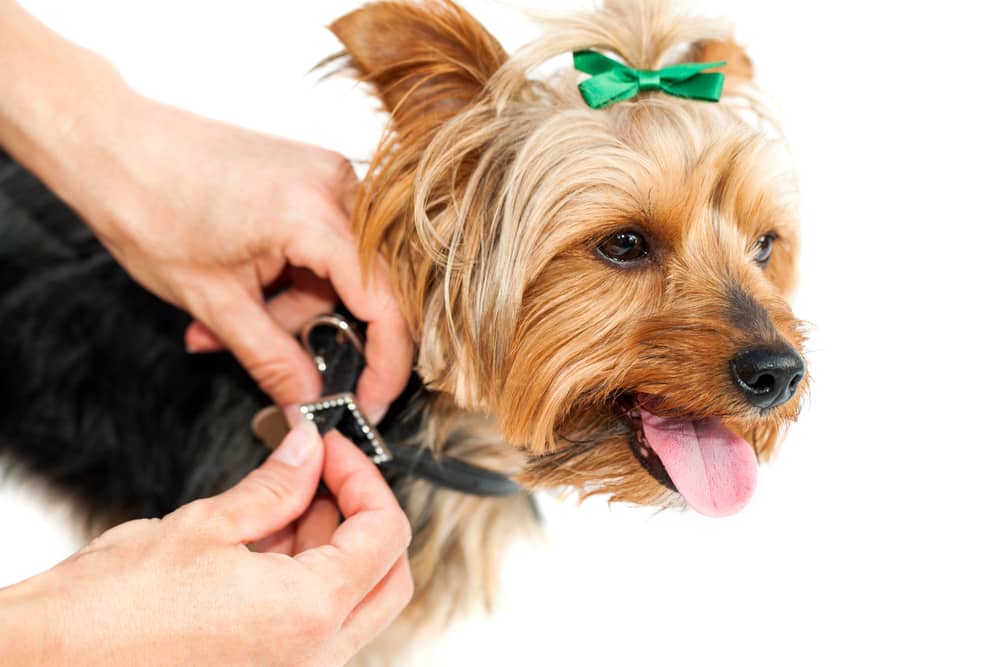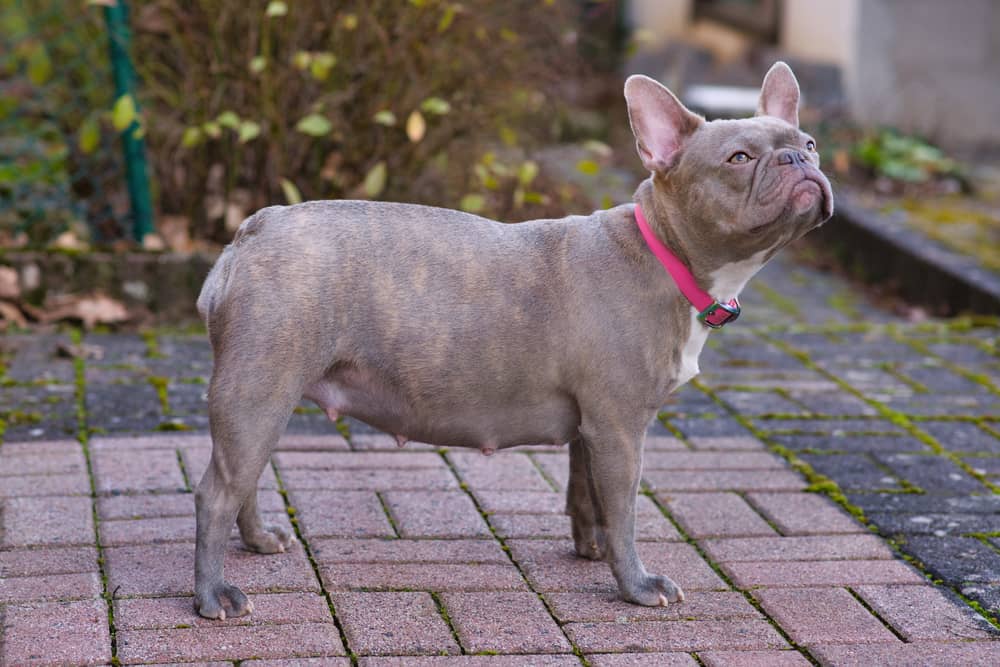Can You Put a Flea Collar on a Pregnant Dog – Amazing Facts
Can you put a flea collar on a pregnant dog is a typical worry because pregnancy can be a sensitive and difficult period for our beloved pals. To protect the welfare of your expectant canine partner.
We’ll answer the most asked questions from pet owners, using a flea collar during pregnancy or can you put a flea collar on a pregnant dog. In this article, we will delve into information that is immensely important to know for pet owners.
Let’s start by talking about the issue of safety. Can you put a flea collar on a pregnant dog without endangering the pups she is carrying? In general, the answer is yes, but there are important safety measures to follow.

Despite the fact that it is normally safe to use a flea collar on a pregnant dog, it is crucial to put her welfare first.
Please seek the advice of your veterinarian, select the appropriate item, confirm a good fit, and keep an eye out for any negative effects.
Can you put a Flea Collar on a Pregnant Dog – Tips to know
You can aid in the pet companion’s flea prevention without endangering her health or the well-being of her developing puppies. Follow these guidelines to learn more about your pet and make well-informed choices:
1. Choose the right flea collar:
People Wondering can I put a flea collar on a pregnant dog should know that when selecting a dog-specific flea collar for their pregnant dog instead of a human-grade option.
Avoid using insecticides or flea collars made for other animals that haven’t been certified for use on dogs.
2. Check with your vet:
Please with your veterinarian before continuing. Based on your dog’s health, stage of pregnancy, and any potential contraindications, they can offer advice that is specifically suited for you.
3. A good fit is important:
Make sure your dog can wear the flea collar properly. A pair of fingers should be able to fit easily between the collar and your dog’s neck when it is secure but not too tight.
4. Regular check:
Check the collar frequently for any indications of itchiness or discomfort. Remove the collar right away if you experience any side effects, including irritation and redness.
5. Natural alternatives:
Consider natural flea-repellent alternatives that can be better for pregnant dogs, such as herbal collars or products based on essential oils.
6. Regular Inspection:
Keep a close eye on your dog’s general health throughout her pregnancy. Any changes in behavior or health should be promptly addressed with your veterinarian.
What Age you can Put a Flea Collar on a Dog
What age you can put flea collar on a dog? It is a common concern raised by pet owners.
Depending on the particular device and the manufacturer’s instructions, there may be a range of acceptable ages to apply a flea collar to a dog.
Generally speaking, the majority of flea collar producers state a minimal age or weight need for using their goods securely.
For safe use, many flea collar packaging list a minimum age or weight restriction.
The manufacturer’s instructions should always be followed, as this can differ from product to product.
Regular grooming and cleaning of a puppy’s living space can help avoid flea infestations in very early puppies.
Check for fleas with a fine-toothed comb and, if required, manually remove them.
WOPET Automatic Smart Feeder Dog Food Dispense with Camera,7L App Control

Depending on the product and the dog’s weight or age, you can put a flea collar on a dog at any age.
To make sure that the flea control methods you use on your puppy or young dog are safe and effective, always read the product label carefully and seek advice from your veterinarian.
How to put a Flea Collar on a Dog:
The technique of attaching a flea collar to your dog is simple. Here is a how-to list to assist you:
- Select the right flea collar:
Choosing the Right Flea Collar Your dog’s size, age, and weight should all be taken into consideration when choosing a flea collar. Carefully read the manufacturer’s instructions and any warnings.
- Prepare your dog:
Make sure your dog is relaxed and comfortable before you begin by preparing him. If your dog appears to be anxious, give them a gentle pet and a soothing word.
- Remove Current Collar:
If your dog already has a collar on, take it off to prevent any interference with the flea collar.
- Unwrap the flea collar:
Take the flea collar out of its container and unwrap it. Some collars could be wrapped in foil or packed in a bag. Make sure to adhere to the guidelines.
- Adjust the fit:
The majority of flea collars can be adjusted for fit. To determine the proper length, place the collar around your dog’s neck and adjust it until two fingers can comfortably fit there. Make sure it is not too tight or too loose.
- Secure the collar:
Put the collar on your dog’s neck securely. Some collars close with a buckle or snap, while others can need the end threaded through a loop. Observe the detailed guidelines that came with the collar.
- Trim Extra Length:
If the collar is too long after it has been fastened, cut it off, leaving just enough for it to function without dangling excessively.
- Check for comfort:
Once the flea collar is on your dog, make sure it doesn’t irritate or give any discomfort to their skin.
Keep an eye out for any indications of discomfort or itching, and take off the collar right once if you do.
- Wash Your Hands:
To prevent exposure to chemicals, wash your hands well with soap and water after handling the flea collar.
- Keep an Eye on Your Dog:
For the first few hours after placing the flea collar on, keep an eye on your dog to ensure that they adjust properly and don’t exhibit any negative reactions.
It’s important to keep in mind that each type of flea collar may have somewhat different application directions, so be sure to read them carefully.
Arm & Hammer Fruit Twisters Fresh Breath Dental Treats for Dogs in Fruity Strawberry Flavor Baking Soda Dog Treats for Dental Health
What Flea Treatment is Safe for Nursing Dog
What flea treatment is safe for nursing dog ? It’s critical to put the safety of the mother dog and the well-being of her puppies first when treating a nursing dog for fleas.
Following are several flea treatments that are typically regarded as secure for nursing dogs:

- Topical flea treatments:
When used in accordance with the manufacturer’s directions, topical flea treatments, such as spot-on solutions, are frequently safe for nursing dogs.
The base of the dog’s neck receives these treatments, making it impossible for the nursing puppies to come into contact with the substance.
To be sure, carefully read the product’s label to see if there are any age or lactation restrictions.
- Oral medicine:
Some oral flea medicines are suitable for dogs that are breastfeeding.
These are often prescription drugs that your vet can suggest based on the particular requirements of your dog.
To ensure the proper dosage and treatment for your nursing dog, it is imperative to see your veterinarian.
- Flea collar:
Some flea collars are made to be safe for dogs that are breastfeeding.
Look for collars that are specifically marked as being safe for ladies who are lactating or nursing.
Pay close attention to the collar’s fitting recommendations to prevent contact with nursing puppies.
Keep in mind that some flea medications may have age or lactation limits and that not all flea treatments are good for nursing dogs.
To guarantee the safety of both the mother dog and her puppies, always heed the advice of your veterinarian and carefully read product labels.
- Natural and Herbal Solutions:
If you want more all-natural solutions, think about using herbal flea repellents or canine-specific products including essential oils.
Prior to utilizing these products, always get advice from your veterinarian or a holistic pet expert to guarantee their efficacy and safety.
Also Read: Big Rope French Bulldog – Ultimate Guide
What Flea Medicine is Safe for Pregnant Dogs:
It’s crucial to put the welfare of the mother dog and her puppies first when applying flea medication to pregnant canines.
Never use over-the-counter flea remedies without first visiting your veterinarian since some of them might not be suitable for dogs that are pregnant.
Professional advice is crucial because the safety of flea management techniques during pregnancy can vary based on the specific dog and the time of pregnancy.
To offer the best guidance for the well-being of your pregnant dog, your veterinarian will take all relevant circumstances into account.
Recommendation for fleas and ticks:
Here are some well-known brands, which are often recommended to pet owners who are concerned about Can I put flea collar on a pregnant dog?
Bravecto for dogs:
Dogs can use the oral flea and tick medicine Bravecto. Fluralaner, an isoxazoline-class substance, is its main active component.
One dose of Bravecto can guard against fleas and ticks for up to 12 weeks, making it renowned for its long-lasting effectiveness.
To accommodate diverse canine sizes and tastes, it is offered in a variety of forms, including topical solutions and chewable pills.
Now question arises , Is Bravecto is safe for pregnant dogs?
Bravecto is a helpful flea and tick control product for dogs.
But its safety during pregnancy has not been defined through clinical trials, and it has not been specifically tested on pregnant or lactating dogs.
For this reason, many veterinarians may recommend alternative flea and tick control methods for pregnant dogs.
Consult your veterinarian if you have a pregnant dog and are thinking about using flea and tick control products.
They can evaluate your dog’s unique situation and provide the most appropriate and secure flea and tick control measures during pregnancy.
Alternative flea treatment options, such as topical treatments, natural remedies, or frequent combing and cleaning.
It allows you to control fleas and ticks without the use of medications which could pose unknown hazards to pregnant dogs and their developing puppies.
Your veterinarian may suggest these methods to help manage fleas and ticks to help minimize potential risks during pregnancy.
WOPET Automatic Smart Feeder Dog Food Dispense with Camera,7L App Control
Seresto Flea Collar
For dogs and cats, the Seresto flea collar is a well-liked and cutting-edge flea and tick control solution.
It stands out for both its convenience and sustained effectiveness.
The Seresto flea collar is an easy and effective way to keep cats and dogs free of fleas and ticks.
It is a popular option for pet owners wishing to defend their furry friends from these prevalent pests because of its efficiency and simplicity of usage.
The Seresto flea collar is described in great detail below. Typically, the Seresto flea collar is a white, odourless, non-greasy collar that may be adjusted to fit dogs and cats of all sizes.
Two active substances have been incorporated into the polymer matrix that makes up the collar.
The Two Main Elements in the Seresto Collar are:
The neonicotinoid class of insecticides includes imidacloprid. Adult fleas are effectively killed by it.
Flumethrin

Flumethrin is an acaricide (kills ticks and mites) and an insecticide. It works to both kill and deter ticks.
The Seresto flea collar’s prolonged period of effectiveness is one of its primary advantages.
A single collar offers protection from ticks and fleas for up to 4 months and up to 8 months, respectively.
It differs from many other flea and tick control solutions, which frequently call for more frequent applications, due to its long-lasting protection.
The collar ensures a constant degree of protection by gradually releasing the active components over time.
It functions by repelling fleas and ticks and destroying them instantly so that they cannot bite and spread disease.
Seresto Collars
Seresto collars are water-resistant, so your pet can swim or get wet without them losing their effectiveness.
However, prolonged exposure to water may shorten its life expectancy. Safety was a priority in the creation of the Seresto collar.
It has a breakaway release mechanism that enables the collar to snap under specific pressure to prevent suffocation in the event that your pet gets tangled up in something.
The Seresto collar is odourless and doesn’t leave a greasy film on your pet’s skin or fur, unlike certain topical flea and tick treatments.
To fit both tiny and large dogs and cats, Seresto offers various collar sizes. Make careful to choose the right size based on the weight of your pet.
The Seresto collar is recommended by several veterinarians as a practical and efficient flea and tick control alternative.
You just wrap the Seresto flea collar around your pet’s neck, tighten it for a secure but comfortable fit, then trim the extra collar length to use it.
For the greatest results, be sure you read and adhere to the detailed instructions that came with the collar.
Is Seresto Collar Safe For Pregnant Humans?
Some pet owners are curious to know that is Seresto collar is safe for pregnant humans. Or it could used for humans too?
The answer is no, It is not safe to use the Seresto flea collar on any human, even those who are pregnant.
It is made specifically to prevent fleas and ticks on dogs and cats.
To protect the safety and health of both humans and dogs, always abide by the manufacturer’s instructions and use items as recommended.
If you are worried about bugs in your home or workplace, ask a healthcare worker for acceptable, individualized remedies.
For the purpose of preventing fleas and ticks on dogs and cats, the Seresto flea collar was specifically created and given approval.
It is not meant to be applied to people. The Seresto collar should not be applied to or placed close to any human beings, including pregnant ones, for the following key reasons.
- Imidacloprid and flumethrin, two active chemicals in the Seresto collar, are designed to be effective against fleas and ticks on pets. These components aren’t meant for human skin or consumption; they’re made for use on animals only.
- The Seresto collar has undergone safety and effectiveness testing for use on dogs and cats, but not on humans.
- There is no information to support the safety of using this product on any human, including pregnant ones.
- Dog and cat skin is not the same as human skin. Applying a pet product to human skin could cause skin rashes, allergies, or other unfavourable reactions.
- Wearing a Seresto collar designed for pets could expose the user to the medication’s active components, which can enter the body through the skin. It is not advised to expose yourself to this since it can be dangerous.
- Use items made specifically for human use if you are worried about fleas and ticks in your environment.
- Humans can use a variety of safe and efficient flea and tick repellents, including lotions, sprays, and garment treatments.
- Consult a dermatologist or healthcare provider for advice on safe and effective ways to protect yourself and your unborn child if you are pregnant and have concerns about fleas or ticks in your home.
NexGard:
A prescription drug called NexGard is given to dogs to treat and prevent flea and tick infestations. Dogs receive an oral, chewable pill once every month.
NexGard is an oral flea and tick treatment for dogs that is available exclusively by prescription. It is renowned for its efficiency, practicality, and monthly dosing regimen.

The finest flea and tick treatment solutions for your dog should be discussed with your veterinarian, as with any medication, to ensure correct administration and security.
Here is a thorough explanation of NexGard:
Afoxolaner, a chemical in the isoxazoline class, is the active component of NexGard. The pesticide and acaricide afoxolaner target the nerve system of fleas and ticks to kill them.
It also kills ticks and mites. NexGard is available as a chewable tablet with a beef flavour, making administration to dogs simple.
The tablet is frequently more enticing to dogs than topical remedies because of how tasty it is.
Adult fleas can be effectively controlled with NexGard. Within hours of consumption, it begins killing fleas, and it keeps doing so for the entire month, preventing new flea infestations.
The monthly dosing schedule for NexGard is one of its main advantages.
One chewable tablet every month is all that pet owners need to give their pets, which is easy and aids in sustaining protection.
NexGard does not become ineffective when bathing or swimming, in contrast to several topical flea and tick treatments. It continues to work if your dog gets wet.
When used as recommended, NexGard is usually regarded as safe for the majority of dogs.
However, some dogs may develop negative side effects from this drug, including nausea, diarrhoea, or lethargy.
Before beginning any new medication, it is imperative to speak with your veterinarian. You should also report any negative side effects.
NexGard must be obtained from your veterinarian because it is a prescription drug.
Based on your dog’s health and individual requirements, your veterinarian can decide whether NexGard is a good fit for them.
Some pet owners may wonder if Nexgard is safe for pregnant dogs
When administered as recommended and under the direction of a veterinarian,
NexGard is usually regarded as safe for the majority of dogs, even those that are lactating or pregnant.
Before giving any medicine, including NexGard, to a pregnant dog, you have to visit your veterinarian.
Although NexGard is frequently regarded as safe for pregnant dogs, it’s important to speak with your veterinarian for specific advice.
Taking into account the unique requirements as well as the wellness of your pregnant dog and her developing puppies, your veterinarian can assist you in making a well-informed choice about flea and tick treatment during pregnancy.
Is Frontline safe for pregnant dogs:
For dogs and cats, Frontline is a brand of topical flea and tick treatments. Frontline is usually regarded as safe for the majority of dogs, which includes those who are pregnant or nursing when taken as indicated.
Nevertheless, it’s imperative to speak with your vet before applying any flea and tick prevention to a pregnant dog.
Keep in mind that the well-being of the particular dog and the stage of pregnancy can affect the safety of any product used during pregnancy.
To guarantee the security and welfare of your pregnant dog and her growing puppies, always put your veterinarian’s advice first.

Can you put Flea Collar on Pregnant Cat
Pet owners often thoughts that can I put flea collar on a pregnant cat. It is typically not advised to use flea collars on pregnant cats because there may be risks to the mother cat as well as her growing kittens.
When it comes to cat pregnancy and flea prevention, it’s critical to put your veterinarian’s advice first.
Based on your cat’s unique circumstances, they may offer the best and safest advice, protecting the welfare of both the mother cat and her unborn kittens.
Some flea collars have active chemicals that might not be safe for cats that are pregnant.
These components might be harmful to the mother cat, the developing kittens, or both. Your veterinarian can advise you on safe and efficient flea prevention techniques.
Alternative flea management measures, like as topical treatments or oral drugs that are especially made to be safe during pregnancy, are frequently advised by veterinarians for pregnant cats.
Based on the specific requirements of your cat, your veterinarian can offer advice.
In addition to treating your cat for fleas, take precautions against flea infestations in the environment. Fleas can be avoided by performing regular cleanings, vacuuming, and environmental treatments using approved materials.
If you choose to use a flea control treatment that your vet suggests, keep a watchful eye on your pregnant cat for any negative side effects, such as irritation to the skin or odd behavior.
Please get in touch with your veterinarian right once if you have any alarming symptoms.





